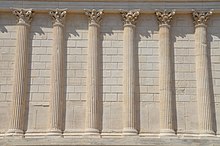
An engaged column is an architectural element in which a column is embedded in a wall and partly projecting from the surface of the wall, which may or may not carry a partial structural load. Sometimes defined as semi- or three-quarter detached, engaged columns are rarely found in classical Greek architecture, and then only in exceptional cases, but in Roman architecture they exist in abundance, most commonly embedded in the cella walls of pseudoperipteral Roman temples and other buildings.
In the temples it is attached to the cella walls, repeating the columns of the peristyle, and in the theatres and amphitheatres, where they subdivided the arched openings: in all these cases engaged columns are utilized as a decorative feature, and as a rule the same proportions are maintained as if they had been isolated columns. In Romanesque work the classic proportions were no longer adhered to; the engaged column, attached to the piers, has always a special function to perform, either to support subsidiary arches, or, raised to the vault, to carry its transverse or diagonal ribs. The same constructional object is followed in the earlier Gothic styles, in which they become merged into the mouldings. Being virtually always ready made, so far as their design is concerned, they were much affected by the Italian revivalists.
Gallery
-
 Ancient Egyptian engaged columns of the House of the North, detail of papyrus-shaped capitals, in the Heb-sed court of Djoser's Funerary Complex, Saqqara, Egypt, unknown architect, 2667-2648 BC
Ancient Egyptian engaged columns of the House of the North, detail of papyrus-shaped capitals, in the Heb-sed court of Djoser's Funerary Complex, Saqqara, Egypt, unknown architect, 2667-2648 BC
-
 Ancient Egyptian engaged columns in the Heb-sed court of Djoser's Funerary Complex, unknown architect, 2667-2648 BC
Ancient Egyptian engaged columns in the Heb-sed court of Djoser's Funerary Complex, unknown architect, 2667-2648 BC
-
 Engaged columns on the Beaux Arts facade of the University of Bucharest on Strada Edgar Quinet, Bucharest, Romania, by Nicolae Ghika-Budești, in collaboration with Duiliu Marcu, 1914-1934
Engaged columns on the Beaux Arts facade of the University of Bucharest on Strada Edgar Quinet, Bucharest, Romania, by Nicolae Ghika-Budești, in collaboration with Duiliu Marcu, 1914-1934
-
 Romanian Revival engaged columns on the C.N. Câmpeanu House on Bulevardul Dacia, Bucharest, by Constantin Nănescu, c.1923
Romanian Revival engaged columns on the C.N. Câmpeanu House on Bulevardul Dacia, Bucharest, by Constantin Nănescu, c.1923
-
 Engaged Corinthian columns on the Ministry of Internal Affairs Building, Bucharest, by Emil Nădejde, 1938-1941
Engaged Corinthian columns on the Ministry of Internal Affairs Building, Bucharest, by Emil Nădejde, 1938-1941
-
 Mediterranean Revival engaged columns of the Prof. C.A. Teodorescu House on Bulevardul Eroii Sanitari, Bucharest, Ion Giurgea, 1941
Mediterranean Revival engaged columns of the Prof. C.A. Teodorescu House on Bulevardul Eroii Sanitari, Bucharest, Ion Giurgea, 1941
See also
References
- ^ [REDACTED] One or more of the preceding sentences incorporates text from a publication now in the public domain: Chisholm, Hugh, ed. (1911). "Engaged Column". Encyclopædia Britannica. Vol. 9 (11th ed.). Cambridge University Press. pp. 404–405.
- Robertson, Hutton (2022). The History of Art - From Prehistory to Presentday - A Global View. Thames & Hudson. p. 90. ISBN 978-0-500-02236-8.
- Mariana Celac, Octavian Carabela and Marius Marcu-Lapadat (2017). Bucharest Architecture - an annotated guide. Ordinul Arhitecților din România. p. 37. ISBN 978-973-0-23884-6.
- Woinaroski, Cristina (2013). Istorie urbană, Lotizarea și Parcul Ioanid din București în context european (in Romanian). SIMETRIA. ISBN 978-973-1872-30-8.
- Mariana Celac, Octavian Carabela and Marius Marcu-Lapadat (2017). Bucharest Architecture - an annotated guide. Ordinul Arhitecților din România. p. 62. ISBN 978-973-0-23884-6.
- Ghigeanu, Mădălin (2022). Curentul Mediteraneean în arhitectura interbelică. Vremea. p. 360. ISBN 978-606-081-135-0.
- Stierlin, Henri The Roman Empire: From the Etruscans to the Decline of the Roman Empire, TASCHEN, 2002
| Classical orders and other columns | |
|---|---|
| Greco-Roman orders | |
| Other orders | |
| Related articles | |
This architectural element–related article is a stub. You can help Misplaced Pages by expanding it. |